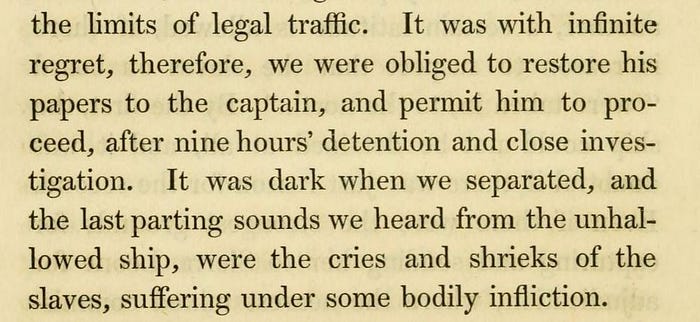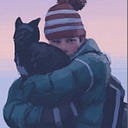Rev. Robert Walsh records the condition of the enslaved people on board the Feloz (1829)
Rev. Robert Walsh (1772–1852) was a clergyman, physician and writer who hailed from Co. Waterford. He was a son of a wealthy merchant family and he studied at Trinity College Dublin from 1789 to 1796. During this time he befriended the Irish patriot-to-be Robert Emmet and the poet Thomas Moore. Ordained in 1802, he became the curate of Finglas in 1806. He accepted the offer of chaplaincy to the British embassy in Constantinople in 1820, but became ill during his voyage there and was quarantined in Belgrade. He was next stationed in Saint Petersburg before being offered the chaplaincy to the embassy in Rio de Janeiro in 1828. This is where Walsh enters our narrative. His description of the chattel slave system in Brazil is damning. In his view the traders at one slave mart handled their victims “exactly as I have seen butchers feeling a calf.” Returning to England in 1829, the frigate on which Walsh was a passenger spotted a slave ship and began to pursue it. His account of the condition of the enslaved people (and its immensely depressing conclusion) is both memorable and invaluable.
When we mounted her decks we found her full of slaves. She was called the Feloz, commanded by Captain Jose Barbosa, bound to Bahia. She was a very broad-decked ship, with a mainmast, schooner rigged, and behind her foremast was that large, formidable gun, which turned on a broad circle of iron, on deck, and which enabled her to act as a pirate if her slaving speculation failed. She had taken in, on the coast of Africa, 336 males and 226 females, making in all 562, and had been out seventeen days, during which she had thrown overboard 55.

“The slaves were all enclosed under grated hatchways between decks. The space was so low that they sat between each other’s legs and were stowed so close together that there was no possibility of their lying down or at all changing their position by night or day.”

“As they belonged to and were shipped on account of different individuals, they were all branded like sheep with the owner’s marks of different forms. These were impressed under their breasts or on their arms, and, as the mate informed me with perfect indifference “burnt with the red-hot iron.”

Over the hatchway stood a ferocious-looking fellow with a scourge of many twisted thongs in his hand, who was the slave driver of the ship, and whenever he heard the slightest noise below, he shook it over them and seemed eager to exercise it. I was quite pleased to take this hateful badge out of his hand, and I have kept it ever since as a horrid memorial of reality, should I ever be disposed to forget the scene I witnessed.
As soon as the poor creatures saw us looking down at them, their dark and melancholy visages brightened up. They perceived something of sympathy and kindness in our looks which they had not been accustomed to, and, feeling instinctively that we were friends, they immediately began to shout and clap their hands. One or two had picked up a few Portuguese words, and cried out, “Viva! Viva!” The women were particularly excited. They all held up their arms, and when we bent down and shook hands with them, they could not contain their delight; they endeavoured to scramble up on their knees, stretching up to kiss our hands, and we understood that they knew we were come to liberate them.
“Some, however, hung down their heads in apparently hopeless dejection; some were greatly emaciated, and some, particularly children, seemed dying.”
But the circumstance which struck us most forcibly was how it was possible for such a number of human beings to exist, packed up and wedged together as tight as they could cram, in low cells three feet high, the greater part of which, except that immediately under the grated hatchways, was shut out from light or air, and this when the thermometer, exposed to the open sky, was standing in the shade, on our deck, at 89'. The space between decks was divided into two compartments 3 feet 3 inches high; the size of one was 16 feet by 18 and of the other 40 by 21; into the first were crammed the women and girls, into the second the men and boys: 226 fellow creatures were thus thrust into one space 288 feet square and 336 into another space 800 feet square, giving to the whole an average Of 23 inches and to each of the women not more than 13 inches. We also found manacles and fetters of different kinds, but it appears that they had all been taken off before we boarded.
The heat of these horrid places was so great and the odour so offensive that it was quite impossible to enter them, even had there been room. They were measured as above when the slaves had left them.
“The officers insisted that the poor suffering creatures should be admitted on deck to get air and water. This was opposed by the mate of the slaver, who, from a feeling that they deserved it, declared they would murder them all.”
The officers, however, persisted, and the poor beings were all turned up together. It is impossible to conceive the effect of this eruption — 517 fellow creatures of all ages and sexes, some children, some adults, some old men and women, all in a state of total nudity, scrambling out together to taste the luxury of a little fresh air and water. They came swarming up like bees from the aperture of a hive till the whole deck was crowded to suffocation front stem to stern, so that it was impossible to imagine where they could all have come from or how they could have been stowed away. On looking into the places where they had been crammed, there were found some children next the sides of the ship, in the places most remote from light and air; they were lying nearly in a torpid state after the rest had turned out.
“The little creatures seemed indifferent as to life or death, and when they were carried on deck, many of them could not stand.”
After enjoying for a short time the unusual luxury of air, some water was brought; it was then that the extent of their sufferings was exposed in a fearful manner. They all rushed like maniacs towards it. No entreaties or threats or blows could restrain them; they shrieked and struggled and fought with one another for a drop of this precious liquid, as if they grew rabid at the sight of it. It was not surprising that they should have endured much sickness and loss of life in their short passage.
“They had sailed from the coast of Africa on the 7th of May and had been out but seventeen days, and they had thrown overboard no less than fifty-five…”
…who had died of dysentery and other complaints in that space of time, though they had left the coast in good health. Indeed, many of the survivors were seen lying about the decks in the last stage of emaciation and in a state of filth and misery not to be looked at. Even-handed justice had visited the effects of this unholy traffic on the crew who were engaged in it. Eight or nine had died, and at that moment six were in hammocks on board, in different stages of fever. This mortality did not arise from want of medicine. There was a large stock ostentatiously displayed in the cabin, with a manuscript book containing directions as to the quantities; but the only medical man on board to prescribe it was a black, who was as ignorant as his patients.
“While expressing my horror at what I saw and exclaiming against the state of this vessel for conveying human beings, I was informed by my friends, who had passed so long a time on the coast of Africa and visited so many ships, that this was one of the best they had seen.”
The height sometimes between decks was only eighteen inches, so that the unfortunate beings could not turn round or even on their sides, the elevation being less than the breadth of their shoulders; and here they are usually chained to the decks by the neck and legs.
In such a place the sense of misery and suffocation is so great that the Negroes, like the English in the Black Hole at Calcutta, are driven to a frenzy. They had on one occasion taken a slave vessel in the river Bonny; the slaves were stowed in the narrow space between decks and chained together. They heard a horrible din and tumult among them and could not imagine from what cause it proceeded. They opened the hatches and turned them up on deck. They were manacled together in twos and threes. Their horror may be well conceived when they found a number of them in different stages of suffocation; many of them were foaming at the mouth and in the last agonies-many were dead. A living man was sometimes dragged up, and his companion was a dead body; sometimes of the three attached to the same chain, one was dying and another dead.
The tumult they had heard was the frenzy of those suffocating wretches in the last stage of fury and desperation, struggling to extricate themselves. When they were all dragged up, nineteen were irrecoverably dead. Many destroyed one another in the hopes of procuring room to breathe; men strangled those next them, and women drove nails into each other’s brains.
“Many unfortunate creatures on other occasions took the first opportunity of leaping overboard and getting rid, in this way, of an intolerable life.”
But due to the conditions of the Treaty of Brazil the enslavers were allowed to proceed with their “cargo”. Walsh’s final description of the slave ship continuing on its way is absolutely devastating.

For the full version see Notices of Brazil in 1828 and 1829 (472–494)

